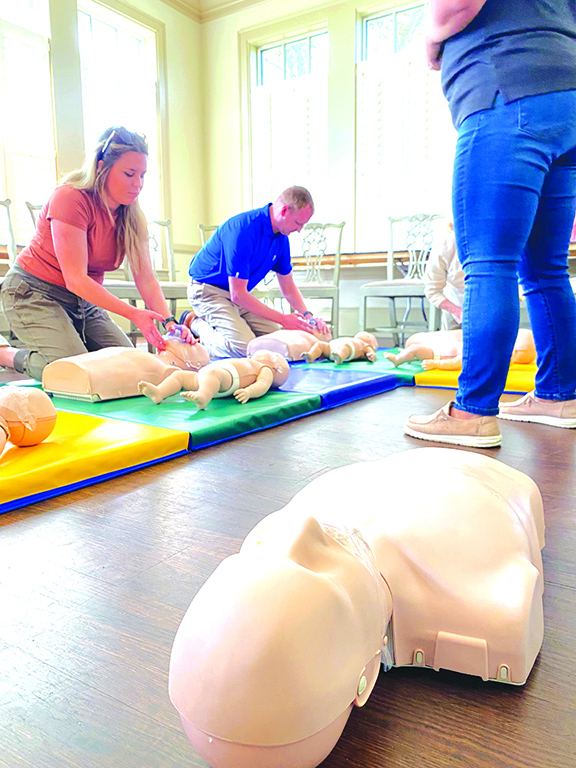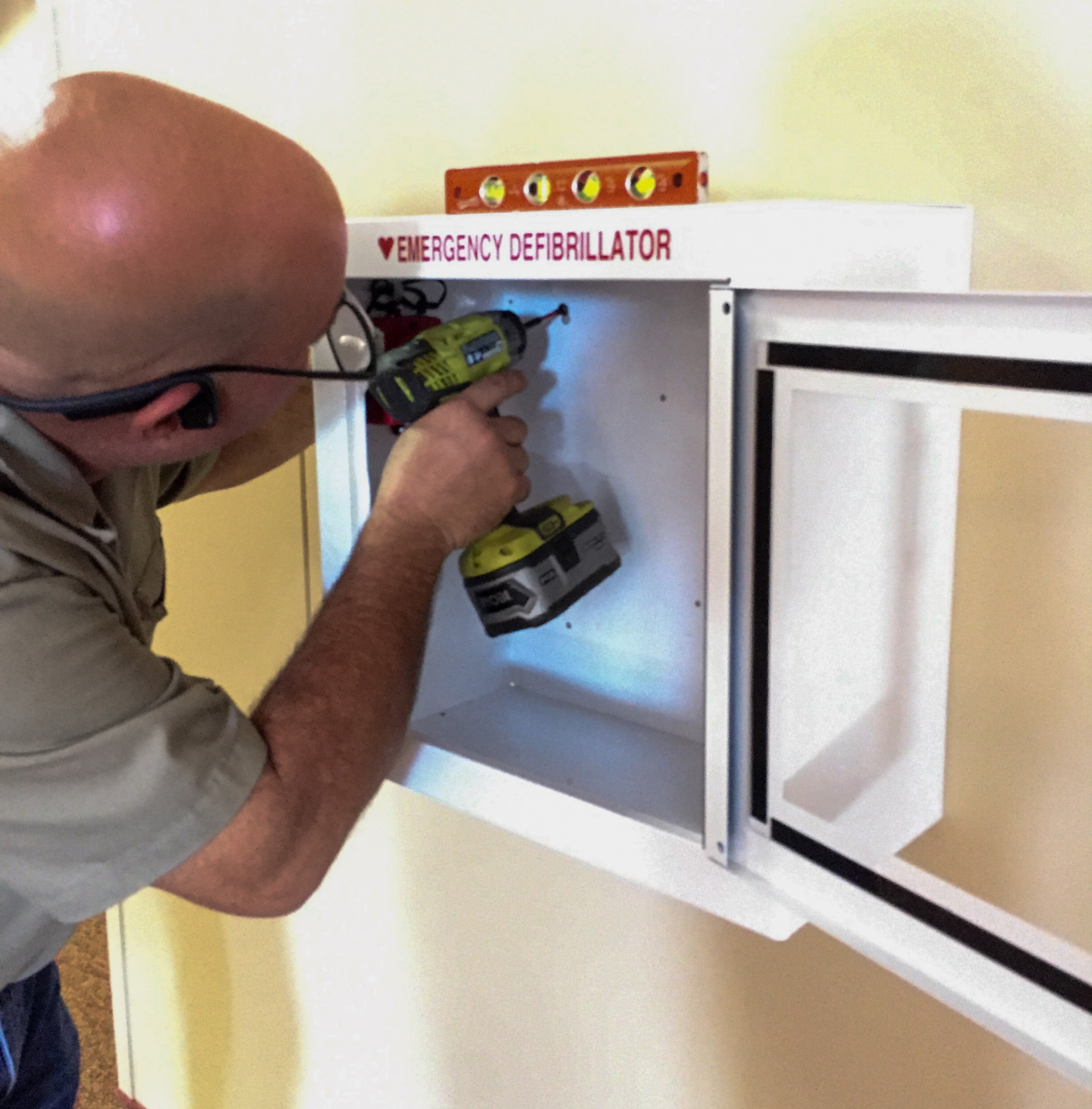BY WIL CREWS
SPORTSCREWS@OPELIKAOBSERVER.COM
LEE COUNTY —
Automated External Defibrillators, more commonly referred to as AEDs, provide a necessary resource to people, families, organizations and communities.
While the average response time for Emergency Medical Services (EMS) in the United States is about eight to 10 minutes, AEDs are a crucial health resource that can help save lives in the immediate aftermath of a medical emergency.
An AED is used to help those experiencing sudden cardiac arrest. It’s a sophisticated, yet easy-to-use, medical device that can analyze the heart’s rhythm and, if necessary, deliver an electrical shock, or defibrillation, to help the heart re-establish an effective rhythm.
According to the American Heart Association, an average of over 350,000 Americans per year suffer cardiac arrest outside of a hospital.
“You could fill Jordan-Hare Stadium over four times with that number,” said Randy Boone, CEO of CarePoint Resources, LLC in Opelika.
Unfortunately, in many instances of cardiac arrest — ones where an AED is not readily available — the survival rate is 9.1%. An average of 75% of those cases happen while at home, and another 10% happen at work.
Based on a study done in Las Vegas Casinos, in instances where an AED is utilized in the first four minutes after the cardiac event, before the arrival of EMS, the chances of survival greatly increase — to 74%.
“The common denominator [in those survival cases] is that the arrest was witnessed,” said Boone, who has a background in EMS and has been a paramedic in private ambulance services, fire-based ambulance services with OFD and hospital-based ambulance services with East Alabama Medical Center for 18 years. “No. 2 is they were able to perform CPR and use an AED almost immediately. No. 3 is they had access to advanced life support care from EMS providers. Those first two are the key.”
Boone knows the importance of AEDs firsthand. Several years ago, while on a shift with the Opelika Fire Department (OFD), Boone received a text from his wife explaining that a performer at First Baptist Church of Opelika’s Vacation Bible School had gone into cardiac arrest. While Boone’s department was not the one that responded to the situation, by the time the emergency crew from OFD arrived on the scene, the performer was conscious, alert and even expressing the desire to not go to the hospital.
It was during the time that OFD was responding to the emergency call that two off-duty health care providers at the church began CPR and instructed a police officer to get the AED from inside the building. The device was on the individual within 60 seconds, according to Boone.
“Eight seconds after that shock was delivered, his heart started beating again in a normal, organized rhythm,” Boone said. “Essentially, exactly what we want an AED to do.”
The quick response and action from the medical professionals and police officer more than likely saved the performer’s life that day. And that is why CarePoint Resources provides its services.
Boone started CarePoint Resources in 2007.
“I started with just a set of mannequins and the desire to help people respond more appropriately to medical emergencies,” Boone said.

The company has grown nationally — and internationally — over the past 15 years, as it mainly functions to place AEDs around the community and provide emergency response training to people from all walks of life.
“Whether you are a paid professional health care provider or just a new parent who wants to know how to help their family if an incident occurs, we help people respond more appropriately to the most common emergencies that we may see,” Boone said.
AEDs are an obvious resource for medical professionals, Boone said; however, professions such as lifeguards and forestry workers require mandatory CPR and first-aid certifications, too. That is why many organizations seek out CarePoint Resources either for training or the placement and maintenance of an AED.
“They come looking for us because they need a class, and typically they needed the class yesterday,” Boone said. “We have a staff of instructors who go out in the community that go to businesses and organizations that want on-site CPR and AED training, as well as AED placement. One of the things our service does is we will maintain AEDs. We can actually pull the date off the device to see the underlying data.”
Although there are many areas of life where CPR and first-aid certification is not regulated, such as new parents, coaches, families of high-risk children or anyone with significant cardiovascular history, Boone encourages everyone to get CPR-certified and familiar with AEDs.
“These are all areas of life where maybe it is not regulated that we have CPR, first-aid training, but if something happens, you would certainly want to have that training in the moment,” he said.
CarePoint Resources carries all the FDA-approved AEDs available in the U.S. While any AED will do the same job, Boone likens AEDs to buying a new car.
“If you’re choosing an automobile, you can choose a Buick or an [Aston Martin]; both will get you from point A to point B just fine,” he said. “However, you might be a little more comfortable using the [Aston Martin] even though you invested a little more money into it. AEDs are the same way. You can purchase one that gives you minimal guidance whenever you are performing a resuscitation, or you can purchase an AED that gives you real-time feedback on your performance.”
Using an AED can be intimidating on the surface. But with some training, the process is rather straightforward, Boone said. For the laymen — if someone suffers sudden cardiac arrest and an AED is accessible to you, the correct response is as simple as:
1. Identifying the extent of the emergency by checking for responsiveness and whether the victim is breathing.
2. Calling 911.
3. Grabbing the AED, turning it on, reading the prompts on how to use the device and administering the shock according to the directions.
4. Starting chest compressions.
Typically, an AED has two pads which are to be put just below the right collarbone and just below the left underarm. Once those pads are in place, the AED takes care of the hard part by identifying whether the person would benefit from a shock or not. Some AEDs will require you to press a button to administer the shock, however some will act automatically.
“It’s important to note that an AED is not going to shock someone who wouldn’t benefit from a shock,” Boone said. “So you can’t just slap this on somebody and shock them just for giggles.”
Moving forward, Boone said he would like to see more AEDs readily available in the community. He suggests having them specifically around areas with municipal complexes.
“We want to see businesses, sporting programs and teams acquiring AEDs,” Boone said. “There typically are already policies, specifically for high school sports, that we don’t do kickoff unless there is an ambulance on standby. But we would like to see a policy where we don’t have a practice or a game unless there is an AED on site.”
Although the price of AEDs can sometimes be a limiter to individuals, the current technological advancements are providing a remedy to monetary barriers. Ultimately, Boone said he would love for AEDs to be common household devices — like a fire extinguisher or thermometer — that are stored for emergencies only. Boone’s family has one. They call it the “football,” and take it with them on any family excursion.
“We don’t have to wonder if the facility we are going to has an AED in place,” he said. “They are small enough, portable enough and becoming affordable enough that families can purchase their own.”
Boone said a common misconception about cardiac arrest is that it only happens to older individuals. This was spotlighted to the entire country just a month ago when Buffalo Bills safety Damar Hamlin collapsed on the field and required emergency medical attention.
“He is not an older individual, and he is not an unfit individual either,” Boone said of Hamlin. “Cardiac arrest is a condition that occurs at any age, and oftentimes it can occur because of undiagnosed congenital cardiovascular issues. Typically, the first sign we see of these issues is when the child initially collapsed with cardiac arrest. And if we are not prepared for it, it is too late. The more people we can reach with this, the better.”

